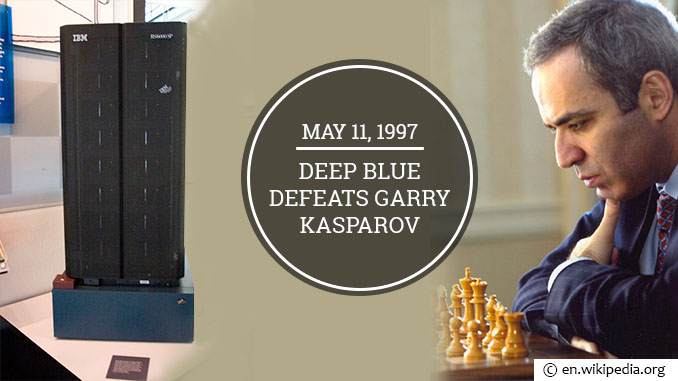Fifteen months after the first man-versus-machine chess match-up, world champion Garry Kasparov faced Deep Blue — an IBM supercomputer — in New York City. Competing in a traditional six-game format, Deep Blue became the first computer to beat a grandmaster on May 11, 1997. In defeating a human at one of the most thought-intensive games ever invented, Deep Blue exploded myths about the limits of digital intelligence. For IBM, the Deep Blue victory was nearly a decade in the making. The project began as a graduate study by Feng-hsiung Hsu while working on his master’s degree at Carnegie Mellon University. Working alongside Thomas Anantharaman and Murray Campbell, Hsu developed ChipTest and its successor, Deep Thought, before receiving his diploma. Matched up with Kasparov and another International Master, Michael Valvo, Deep Thought was comprehensively beaten by both in two-game matches in 1989. Intrigued by the possibilities of a chess-playing computer capable of world-class strategy, the research and development arm of IBM snatched the three programmers up and allowed them to continue their work. In Hsu’s mind, the best way to improve the platform involved tapping other chess experts to help the programmers understand the intricacies of top-level play. Grandmaster Joel Benjamin, an opponent for the Deep Blue, Jr. test machine, agreed to help the IBM Research team refine the Deep Blue prototype during the early 1990s. Satisfied with the progress made by 1995, Hsu entered the machine in the World Computer Chess Championship in Hong Kong. The competition proved stiff — Deep Blue only managed a draw to the Wchess program and a loss to Fritz chess software, the eventual champion. Finishing in a tie for second place, Hsu and the IBM Research engineers returned home in a buoyant mood. Confident their creation could produce a better showing against Kasparov after an additional seven years of improvement allowed Deep Blue to comprehend 200 million piece arrangements per second, IBM Research issued a new challenge for a tournament-style match against the champion in February 1996. Arriving in Philadelphia, Kasparov agreed to a straight-up six-game contest against Deep Blue with Hsu and other programmers consulting other chess masters to adjust the software in between rounds. The first game, played on February 10, 1996, resulted in an upset for the supercomputer against the human world champion. The next five games were much different: Kasparov won three and the other two were draws. The 4-2 scoreline did not do Deep Blue justice — one of the drawn games took 73 moves! Hsu and his team returned to IBM armed with a fresh desire to prove the worth of their program. For over a year, engineers rebuilt the machine in order to squeeze out maximum performance from the software and hardware. Determined to test the changes once again, IBM Research approached Kasparov about a rematch against “Deeper Blue,” the programmers’ codename for the adjusted version of his previous opponent. Set up in New York City, the second competition pitting man against machine took a few unexpected turns. The first game, won by Kasparov, included a move the champion later attributed to “superior intelligence” — a subtle accusation of cheating leveled at the IBM team. Flustered by the possibility of an unfair advantage, Kasparov dropped the second game when he could have forced a draw. With the score even at 1, the next three rounds were all even. In the decisive sixth game, Kasparov’s strategy was thrown off by Deep Blue opting to throw away one knight, a move which opened the board for the supercomputer to attack. Realizing the chances for a victory slim and forcing a tie would take dozens of moves, Kasparov opted to cede the match to Deep Blue by a score of 3.5-2.5 on May 11, 1997. In the wake of defeat, Kasparov asked for a log of the moves Deep Blue made — he hoped to prove illegal interference by the chess experts during each game in question, particularly the second. IBM denied his request, opting to dismantle the machine instead and brushing aside his requests for a rematch. Kasparov refused to believe Deep Blue had the capacity to choose some of its more creative actions, but the small number of games played — only 12 — did not provide statisticians with a large enough sample to determine whether a move was outside the machine’s “normal.” For years, the chess-obsessed Internet forums have buzzed with discussion about the implications for Kasparov’s defeat — the only one in his illustrious career. Though commenters fall on both sides of the discussion, the debate has produced an interesting theory as to the cause of the momentous result – Wired magazine reported in September 2012 that a bug in Deep Blue’s software may have produced the move Kasparov found so strange. The sacrifice “sent Gary into a tizzy,” said fellow grandmaster Yasser Seirawan in 2001, meaning his emotions may have gotten the best of him — a problem the cold, calculating Deep Blue could never have. Also On This Day: 482 – Byzantine Emperor Justinian I is born. 868 – A manuscript of the Diamond Sutra is printed in China, the oldest confirmed printing date in the world. 1310 – Heresy convictions lead to 54 Knights Templar being burned at the stake in France. 1857 – Indian rebels seize Delhi from the British as part of the Indian Revolution. 1924 – Gottlieb Daimler and Karl Benz merge their companies to form Mercedes Benz.
May 11 1997 – Deep Blue Defeats Garry Kasparov
Fifteen months after the first man-versus-machine chess match-up, world champion Garry Kasparov faced Deep Blue — an IBM supercomputer — in New York City. Competing in a traditional six-game format,…
